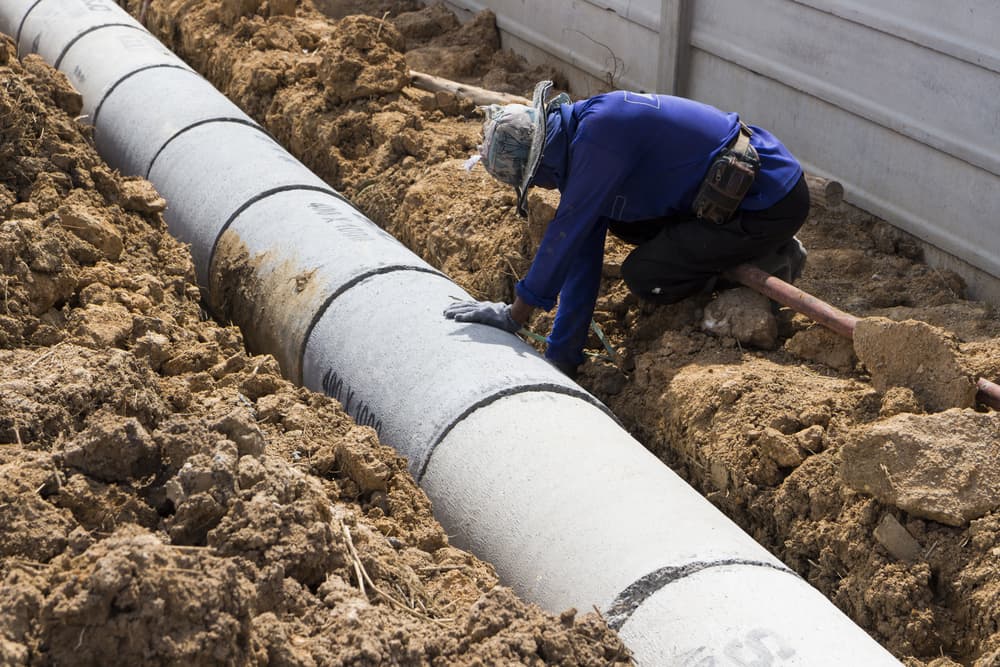Asbestos cement pipes were frequently used in the past for water allocation, potable drinking water, storm drains, industrial processes, and sewer drains. They were commonly called Transite pipes. Transite was once a brand name for asbestos cement patented and made by Johns Manville. Due to the popularity of the product, it became a household term for all asbestos cement pipes.
Cement pipes were first used during the 1930s and contained up to 20 percent asbestos. When the pipes were introduced, manufacturers promoted them as being indestructible. However, they do deteriorate and break with age. This can lead to asbestos exposure, which may require the expertise of an asbestos lawyer to address legal concerns related to exposure and compensation.
Speak to an Asbestos Attorney If You’ve Worked with Cement Pipes and Have an Asbestos-Related Condition
If you’ve been exposed to asbestos and worked with these pipes in the past, you need to speak to an asbestos attorney about your condition and what you can do to receive compensation.
Pipefitters and plumbers are not the only people who have been exposed. Employees in the manufacturing, construction, and maintenance fields were also potentially exposed. Oil refinery workers, furnace workers, electricians, and carpenters also may have been exposed.
Asbestos in Drinking Water

The U.S. Environmental Protection Agency (EPA) published a report in 1979 that reviewed the danger of asbestos in cement pipes. The agency suggested that most people who drank water from cement pipes may have been exposed to as much as one million asbestos fibers per liter, especially in the Bay Area and the Pacific Northwest of the U.S.
Moreover, according to the Drinking Water Foundation, U.S. utilities provided “aggressive water” or water that can dissolve asbestos to the populace. This type of water is also called corrosive water. According to the EPA, people who drank corrosive water from cement pipes were exposed to 10 million fibers of asbestos per liter. Currently, the EPA allows 7 million fibers per liter in drinking water supplies.
Studies of Utah drinking water transported in cement pipes also showed increased incidences of kidney cancer and gastrointestinal cancer.
Talk to an Asbestos Lawyer About Your Case
So, if you’ve drank water from cement pipes and have been diagnosed with an asbestos condition, you may have a reason to file a lawsuit. That’s why it’s in your best interest to speak to a personal injury lawyer who handles asbestos cases. They can find the root of the exposure and determine what parties are liable for your disease.
Cement Pipes in the Workplace
While plumbers, fitters, and other employees may have first been exposed to asbestos when they initally installed or manufactured pipes, pipe insulation, flanges, valves, and gaskets, others can still be exposed today, due to prior installations.
For instance, workers may still be exposed to asbestos in cement pipes if they cut, remove, or repair a pipe. Also, exposure may occur during a building inspection or a renovation. A worker may simply bump into a pipe that’s been insulated with asbestos and disturb the lagging, thereby releasing a substantial amount of friable asbestos into the air.
Maintenance workers or millwrights who remove flanges, valves, or gaskets in older industrial equipment, such as components found in boiler rooms, on large vessels, and at oil refinery sites, may be at risk for exposure. Electricians may also be exposed when they cut cement conduit pipes that contain asbestos.
Construction workers often are exposed to asbestos in cement pipes during demolitions.
Because asbestos was once extensively used in cement pipes, it may still be found in older buildings and the drinking water system of some towns and cities. In older homes, the pipes may sit beneath a slab, making it difficult to repair or replace them. In infrastructure, the pipes are frequently found under a road or a bridge.
Phoenix was the last major metropolitan area in the U.S. to use asbestos cement pipes in its water system. In 1994, Phoenix was repairing or replacing cement pipes with new asbestos cement pipes originating from Mexico.
One abatement contractor in the Phoenix area stated that the asbestos cement pipes are being replaced with other materials when road improvements are made. However, many of the public works water pipes still contain asbestos.

Asbestos Cement Pipes Used in Industry
Asbestos cement pipes are known to be non conductive to electricity. They are also soundproof, chemically inert, and non-corrosive. Therefore, when they were popular, they were often used to transport water, gasses, and other materials.
Industrial uses for asbestos cement pipes include:
- Conduit lines for telecommunications and electrical wires
- High-pressure lines for freshwater
- Sewer lines that transport water from homes to wastewater treatment facilities
Steel Pipes that Contain Asbestos
Besides cement pipes, asbestos may also be found in steel pipes. In fact, steel pipes may contain as much as 15 percent asbestos, according to one asbestos testing company. Asbestos has been used in steel pipes to reduce the pipes conductivity and increase safety in places prone to static charges. The pipes were formerly used to move liquids subject to high pressure.
Asbestos in Pipe Insulation

Asbestos has also been used in pipe insulation because of its high thermal value and resistance to moisture, heat, fire, chemicals, and electricity. Insulated water pipes keep hot water hot and prevent condensation from forming on cold water pipes.
Insulation with asbestos was extensively used in factories, homes, ships, and in industrial settings. It’s often found in boiler rooms, around water heaters and covering steam-heated pipes. The insulation is used in oil refineries, on ships, and in factories.
Just because a pipe is wrapped in insulation doesn’t mean the asbestos is airborne. It may still be intact. Only when asbestos is disturbed is it released into the air.
For example, non-friable asbestos is not easily disturbed. It requires mechanical destruction of an item by cutting, sanding, or drilling. On the other hand, friable asbestos may easily be disturbed and, therefore, needs to be abated ASAP.
In fact, some asbestos is so fragile that you can disturb it and release it by creating a vibration, such as slamming a door.
Asbestos pipe wrap was applied as a spray, plaster mud, or prefab wrap. The prefabricated wrap resembled white corrugated cardboard. All three types were considered friable.
Some of the pipe insulation used, was made of felt or paper, which is sometimes non-friable. These types usually have a high content of asbestos. Insulation for steel pipes is often made of pure asbestos. The EPA banned spray-on and prefab asbestos pipe insulation in 1973.
However, insulation was prevalent before then, and houses built prior to 1973 may still contain the insulation. It may also be found in industrial settings where the equipment and machines are older.
Asbestos in PVC Pipes
PVC pipes or polyvinyl chloride pies are typically considered a safe alternative to an asbestos cement pipe. However, they can still contain asbestos. This is because chlorine is a major ingredient in the making of PVC. Therefore, around 18 percent of the chlorine in the U.S. is still made using asbestos diaphragms. Asbestos may leach into chlorine and eventually into PVC pipes.
Contact an Asbestos Lawyer Today
If you have been diagnosed with mesothelioma, lung cancer, or asbestosis and believe it was due to exposure to asbestos in pipes, you should discuss your situation with an asbestos attorney at Vogelzang Law. Whatever the reason for your exposure, a lawyer can review your case and help you move forward with a claim. Find out more about your rights today.



